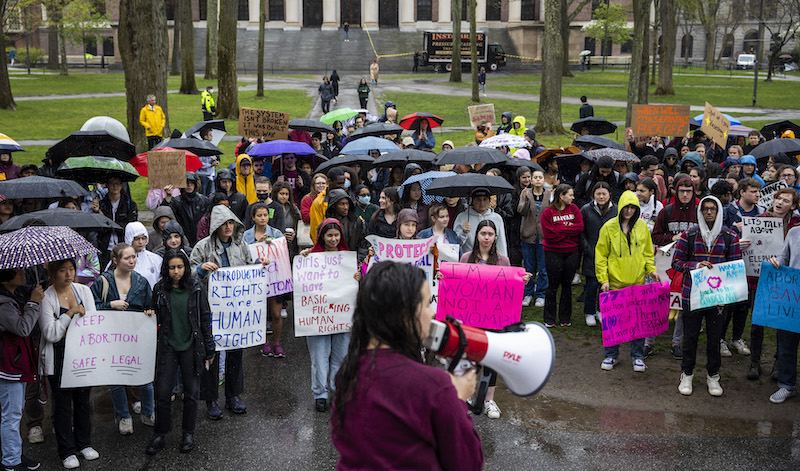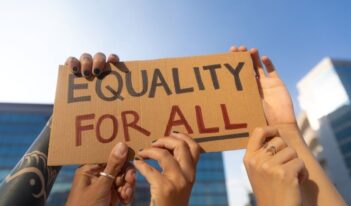
A leaked draft of a Supreme Court opinion turns the national debate over Roe v. Wade on its head.
What do celebrity sex tapes and drafts of Supreme Court decisions have in common? Both can be leaked.
For nearly 50 years, Roe v. Wade has stood as the Supreme Court decision that crystallized the constitutional right to have an abortion. But last week, news broke that the Supreme Court may overrule its 1973 decision.
Word of Roe’s likely abandonment arrived in an unconventional package: a draft opinion of a current case before the Court, Dobbs v. Jackson Women’s Health Organization, released to the media by an unidentified source. Chief Justice John Roberts verified the legitimacy of the leaked document, but commented that the draft did not necessarily reflect a final decision. Roberts called for an investigation to identify the source of the leak.
The Dobbs case centers on a Mississippi ban on abortions that take place after 15 weeks of pregnancy—a time period which on its face contravenes Roe’s central rule that states cannot constitutionally prohibit abortions before viability. “Viability” denotes the gestational age of the fetus at which it could survive outside of the uterus, which is generally understood to be at about 23 or 24 weeks of pregnancy.
The main question at issue in Dobbs is whether “all pre-viability prohibitions on elective abortions are unconstitutional.” Justice Samuel Alito, the author of the leaked draft opinion in Dobbs, responds that prohibitions before the point of viability are constitutional.
In his draft opinion, Justice Alito calls Roe “egregiously wrong from the start” and an “abuse of judicial authority.”
Roe v. Wade established a framework for protecting a pregnant person’s right to choose, holding that the State’s interest in the “potentiality of human life” becomes the most compelling at the point of viability. According to the Supreme Court in Roe, when pregnancy reaches this point, the State can “regulate, and even proscribe, abortion, except where necessary, in appropriate medical judgment, for the preservation of the life or health of the mother.”
But in the draft Dobbs opinion, the Supreme Court appears ready to say that the government can intervene with constraints on abortion before the fetus realizes the point of potential for human life. The draft says that the ultimate determination on any constraints on abortion should be left to state legislatures.
A potential Dobbs decision based on the reasoning in the Alito draft would find itself up against a line of cases that affirms the fundamental right to privacy. In Roe, the Supreme Court had specifically named the criminalization of abortion as a violation of the “Due Process Clause of the Fourteenth Amendment, which protects against state action the right to privacy, including a woman’s qualified right to terminate her pregnancy.”
Commentators on the Dobbs draft decision fear that if Roe falls, other Supreme Court precedent will too. Other cases in which the court has read a general right to privacy into the constitutional meaning of “liberty” include Loving v. Virginia, which safeguards the right to interracial marriage, and Obergefell v. Hodges, which protects the right to gay marriage.
To some observers, Alito’s draft majority opinion appears to signal a Court increasingly willing to allow states to reach into private decisions. At least with respect to abortion, individual states’ elected legislators would be able to decide what restrictions to place on abortion, including banning abortion altogether.
If the Supreme Court overturns Roe, at least 23 states would likely implement restrictions on abortion rights or complete bans on abortion. Some of these states have “trigger laws” in place, which are rules limiting access to abortion that would go into effect immediately in the event that Roe is thrown out. These laws would affect about 40 million reproductive-aged individuals who live in these states.
The draft opinion would also overturn Planned Parenthood v. Casey, the Supreme Court’s 1992 decision that reaffirmed the core of the Roe holding that pregnant people possess the right to choose an abortion before fetal viability. Pre-viability abortions, according to the opinion, should be completely free from governmental interference. After viability, however, Casey makes room for states to impose restrictions on abortion, such as a required waiting period before a pregnant individual is able to have an abortion.
The news of the Supreme Court possibly overturning Roe and Casey arises against a backdrop of high rates of maternal mortality in the United States. Researchers estimate that deaths relating to pregnancy would rise by roughly 21 percent if state bans on abortions took hold. In addition, these bans would have disproportionate racial effects, as the likelihood of Black women dying at the hands of pregnancy and delivery-related complications in the United States is three to four times higher than that of white women.
Activists on both sides of the political aisle gathered on the steps of the Supreme Court and in streets across the country last week to protest the potential ruling. Speaking to protestors assembled outside of the Supreme Court, Senator Elizabeth Warren (D-Mass) decried the possible overturn of Roe, saying that the individuals who will be most impacted by this decision are low-income populations, the Black community, and victims of sexual crimes.
The day after the draft opinion was made public, President Joseph R. Biden released a statement declaring that the right to choose is “fundamental.” He emphasized that elected authorities at all level of government will be responsible for safeguarding that right if the Dobbs decision as drafted becomes final.
Although a leak of a Supreme Court decision of this magnitude stands unprecedented, some observers have pointed out that this event does not come without its fair share of irony. A Supreme Court clerk reportedly leaked the result of Roe v. Wade to a magazine journalist in January 1973 before the official publication of the ruling by the Court. In the days since the news of the Dobbs draft opinion hit the stands, many theories about the identity of the individual responsible for the early release have popped up.
Advocates have argued that the method by which the public learned of this draft decision should not, however, detract from the substance and gravity of the draft itself. If the draft becomes final, the Court’s decision would profoundly alter the United States’ approach to abortion.



